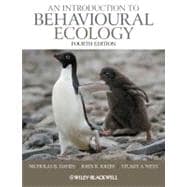
What is included with this book?
John R. Krebs FRS is Principal of Jesus College and Professor in the Department of Zoology at the University of Oxford, and a member of the House of Lords.
Stuart West is Professor of Evolutionary Biology in the Department of Zoology at the University of Oxford.
Acknowledgements xiii
1 Natural Selection, Ecology and Behaviour 1
Watching and wondering 1
Natural selection 5
Genes and behaviour 6
Selfish individuals or group advantage? 11
Phenotypic plasticity: climate change and breeding times 18
Behaviour, ecology and evolution 21
Summary 22
Further reading 22
Topics for discussion 23
2 Testing Hypotheses in Behavioural Ecology 24
The comparative approach 25
Breeding behaviour of gulls in relation to predation risk 26
Social organization of weaver birds 28
Social organization in African ungulates 30
Limitations of early comparative studies 31
Comparative approach to primate ecology and behaviour 33
Using phylogenies in comparative analysis 37
The comparative approach reviewed 45
Experimental studies of adaptation 46
Summary 49
Further reading 50
Topics for discussion 51
3 Economic Decisions and the Individual 52
The economics of carrying a load 52
The economics of prey choice 59
Sampling and information 62
The risk of starvation 63
Environmental variability, body reserves and food storing 65
Food storing birds: from behavioural ecology to neuroscience 66
The evolution of cognition 71
Feeding and danger: a trade-off 73
Social learning 75
Optimality models and behaviour: an overview 79
Summary 81
Further reading 82
Topics for discussion 82
4 Predators versus Prey: Evolutionary Arms Races 83
Red Queen evolution 83
Predators versus cryptic prey 86
Enhancing camouflage 92
Warning colouration: aposematism 95
Mimicry 100
Trade-offs in prey defences 103
Cuckoos versus hosts 105
Summary 113
Further reading 114
Topics for discussion 114
5 Competing for Resources 116
The Hawk–Dove game 116
Competition by exploitation: the ideal free distribution 119
Competition by resource defence: the despotic distribution 123
The ideal free distribution with unequal competitors 123
The economics of resource defence 126
Producers and scroungers 130
Alternative mating strategies and tactics 131
ESS thinking 142
Animal personalities 143
Summary 144
Further reading 145
Topics for discussion 146
6 Living in Groups 147
How grouping can reduce predation 148
How grouping can improve foraging 159
Evolution of group living: shoaling in guppies 163
Group size and skew 164
Group decision making 169
Summary 177
Further reading 177
Topics for discussion 178
7 Sexual Selection, Sperm Competition and Sexual Conflict 179
Males and females 180
Parental investment and sexual competition 182
Why do females invest more in offspring care than do males? 184
Evidence for sexual selection 186
Why are females choosy? 189
Genetic benefits from female choice: two hypotheses 194
Testing the hypotheses for genetic benefits 196
Sexual selection in females and male choice 201
Sex differences in competition 204
Sperm competition 205
Constraints on mate choice and extra-pair matings 208
Sexual conflict 209
Sexual conflict: who wins? 216
Chase-away sexual selection 218
Summary 220
Further reading 221
Topics for discussion 221
8 Parental Care and Family Conflicts 223
Evolution of parental care 223
Parental investment: a parent’s optimum 227
Varying care in relation to costs and benefits 229
Sexual conflict 232
Sibling rivalry and parent–offspring conflict: theory 238
Sibling rivalry: evidence 240
Parent–offspring conflict: evidence 243
Brood parasites 249
Summary 252
Further reading 252
Topics for discussion 253
9 Mating Systems 254
Mating systems with no male parental care 254
Mating systems with male parental care 264
A hierarchical approach to mating system diversity 279
Summary 280
Further reading 281
Topics for discussion 281
10 Sex Allocation 282
Fisher’s theory of equal investment 285
Sex allocation when relatives interact 286
Sex allocation in variable environments 296
Selfish sex ratio distorters 304
Summary 305
Further reading 305
Topics for discussion 306
11 Social Behaviours: Altruism to Spite 307
Kin selection and inclusive fitness 308
Hamilton’s rule 313
How do individuals recognize kin? 318
Kin selection doesn’t need kin discrimination 322
Selfish restraint and kin selection 325
Spite 327
Summary 331
Further reading 332
Topics for discussion 333
12 Cooperation 334
What is cooperation? 334
Free riding and the problem of cooperation 336
Solving the problem of cooperation 337
Kin selection 339
Hidden benefits 341
By-product benefit 341
Reciprocity 345
Enforcement 350
A case study – the Seychelles Warbler 354
Manipulation 356
Summary 358
Further reading 358
Topics for discussion 359
13 Altruism and Conflict in the Social Insects 360
The social insects 360
The life cycle and natural history of a social insect 364
The economics of eusociality 366
The pathway to eusociality 366
The haplodiploidy hypothesis 367
The monogamy hypothesis 371
The ecological benefits of cooperation 375
Conflict within insect societies 379
Conflict over the sex ratio in the social hymenoptera 379
Worker policing in the social hymenoptera 386
Superorganisms 389
Comparison of vertebrates with insects 390
Summary 392
Further reading 392
Topics for discussion 393
14 Communication and Signals 394
The types of communication 395
The problem of signal reliability 396
Indices 397
Handicaps 405
Common interest 411
Human language 416
Dishonest signals 417
Summary 421
Further reading 422
Topics for discussion 423
15 Conclusion 424
How plausible are our main premises? 424
Causal and functional explanations 436
A final comment 438
Summary 441
Further reading 441
References 442
Index 489
COMPANION WEBSITE
This book is accompanied by a companion website: www.wiley.com/go/davies/behaviouralecology
With figures and tables from the book for downloading
The New copy of this book will include any supplemental materials advertised. Please check the title of the book to determine if it should include any access cards, study guides, lab manuals, CDs, etc.
The Used, Rental and eBook copies of this book are not guaranteed to include any supplemental materials. Typically, only the book itself is included. This is true even if the title states it includes any access cards, study guides, lab manuals, CDs, etc.